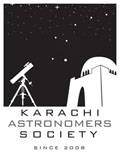[85:1] I swear by the mansions of the stars.
The unpolluted night sky is one of the most wondrous things that the mortal eye can conceive. No fancy equipment is needed. Just the urge to gaze skywards on a clear, cloudless night is your ticket to enjoying the captivating show of earthly and celestial lights. In the following we sample some of the open secrets of the night sky.
1. The Milky Way
As you probably already know, this is the name of our home galaxy. Although some part of it is always above the horizon at any given time of the year, very few city people today have seen it due to light pollution (misdirected and excessive outdoor light). This is a very sad state of things. Seeing the Milky Way in all its glory is a truly spiritual experience. The intricate dust lanes, bejeweled star clusters and distant star clouds in and around the plane of our galaxy can keep one occupied for hours at end. At times of the year, the Milky Way can be so bright it casts faint shadows!
The summer Milky Way seen 160km from Karachi (Photo by
Hanif Bhatti)
2. The Zodiacal Light
Another display that can be seen every clear, Moonless night from unpolluted locations in tropical and sub-tropical latitudes is the zodiacal light. Interestingly, this delicate pyramid of ghostly light has a special significance in Islam. We all know that the time of Fajr salah starts at Subha-e-Sadiq (true dawn). Did you ever wonder that if there is a true dawn, there must also be a false dawn? There is, in fact, a false dawn (Subha-e-Kazib) every night that can be seen when the Moon is not in the sky. This is called the zodiacal light in English; it appears towards the east before dawn and also towards the western horizon after dusk when the sky has darkened sufficiently.
The zodiacal light is sunlight reflecting off the billions of tiny dust particles that orbit the Sun in the plane of the solar system.
3. Total Lunar Eclipses
The Earth casts a long shadow in space. Once or twice every year, the Moon passes through this shadow. If the Moon happens to cross its darker part, the eclipse is said to be total. The Moon does not become invisible because the Earth’s atmosphere bends some amount of sunlight which then falls on the eclipsed Moon to give it a coppery hue. Total lunar eclipses can be seen by everyone on the night side of the Earth.
4. Meteors and Fireballs
These are rocks and dust particles that enter the Earth’s atmosphere and vaporize due to the extreme heat of friction. Whether they are sporadic or part of a shower, meteors can put up delightful displays of activity in an otherwise still sky. In November 1966, observers in Japan and the US saw an unbelievable number of meteors in the span of a few hours – up to forty meteors per second.
A fireball is a very bright meteor. Some fireballs can become as bright as the full Moon.
5. Comets
Have you seen a bright comet? If yes, you know that it is an astonishing sight. Fortunately or unfortunately, bright comets are extremely rare. An exceptionally bright comet, Ikeya-Seki, was seen from Pakistan right after the Indo-Pak War in 1965. Even many young children who saw it remember it vividly. The next bright comets came in 1996 (Hyakutake) and 1997 (Hale-Bopp). A very bright comet appeared in 2007 but it could be best seen only from the southern hemisphere.
Reflecting Upon What You See
The next time you see a blazing meteor, the Milky Way arching from horizon to horizon, the delicate pyramid of the zodiacal light or simply a slender crescent hovering against a darkening sky, take a moment to reflect on the two eyes that made it possible for you to see these sights in the first place. Think of those who were born blind, or who lost the ability of see in their later years, and thank Allah Pak for the priceless gift of sight.





